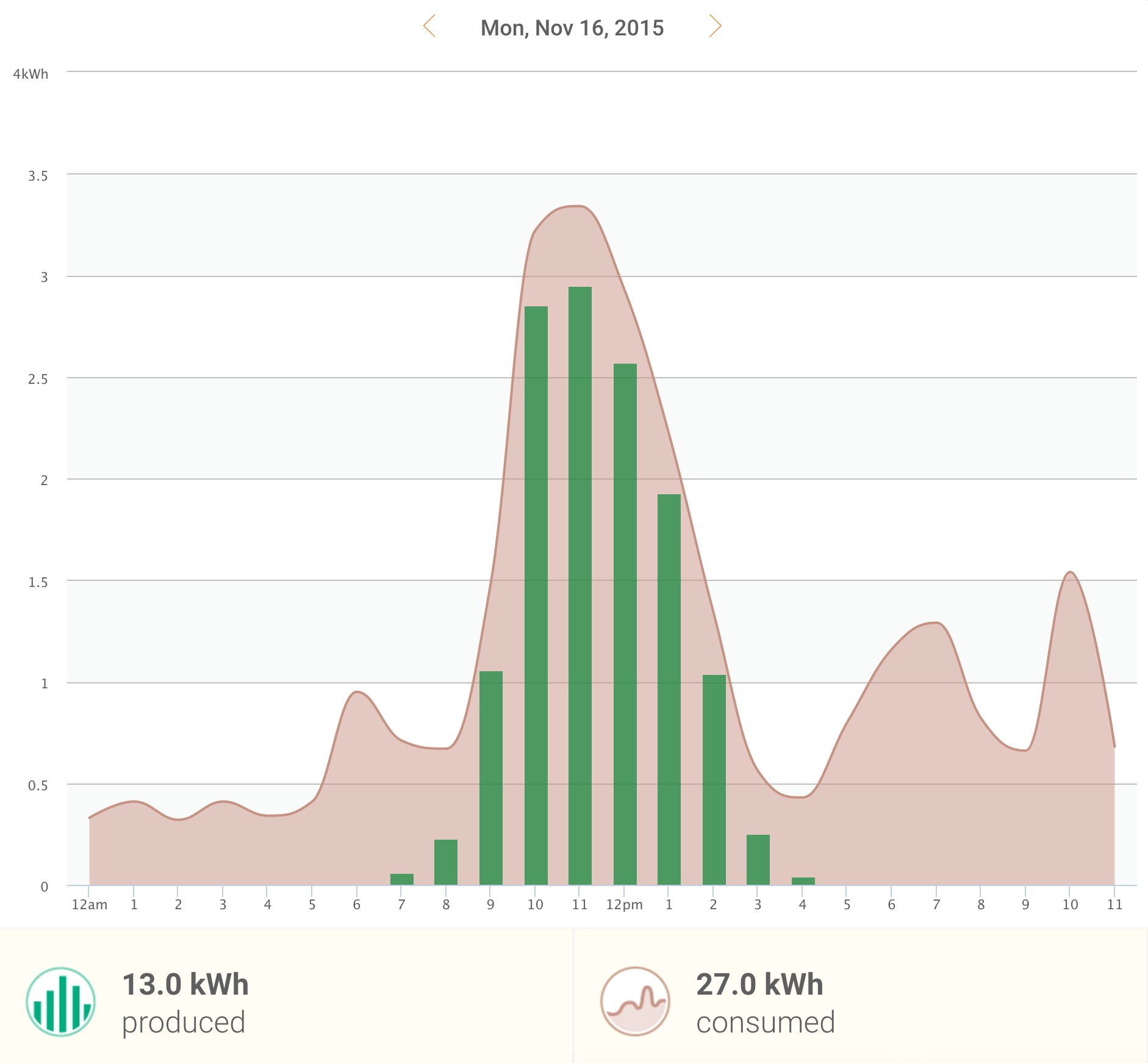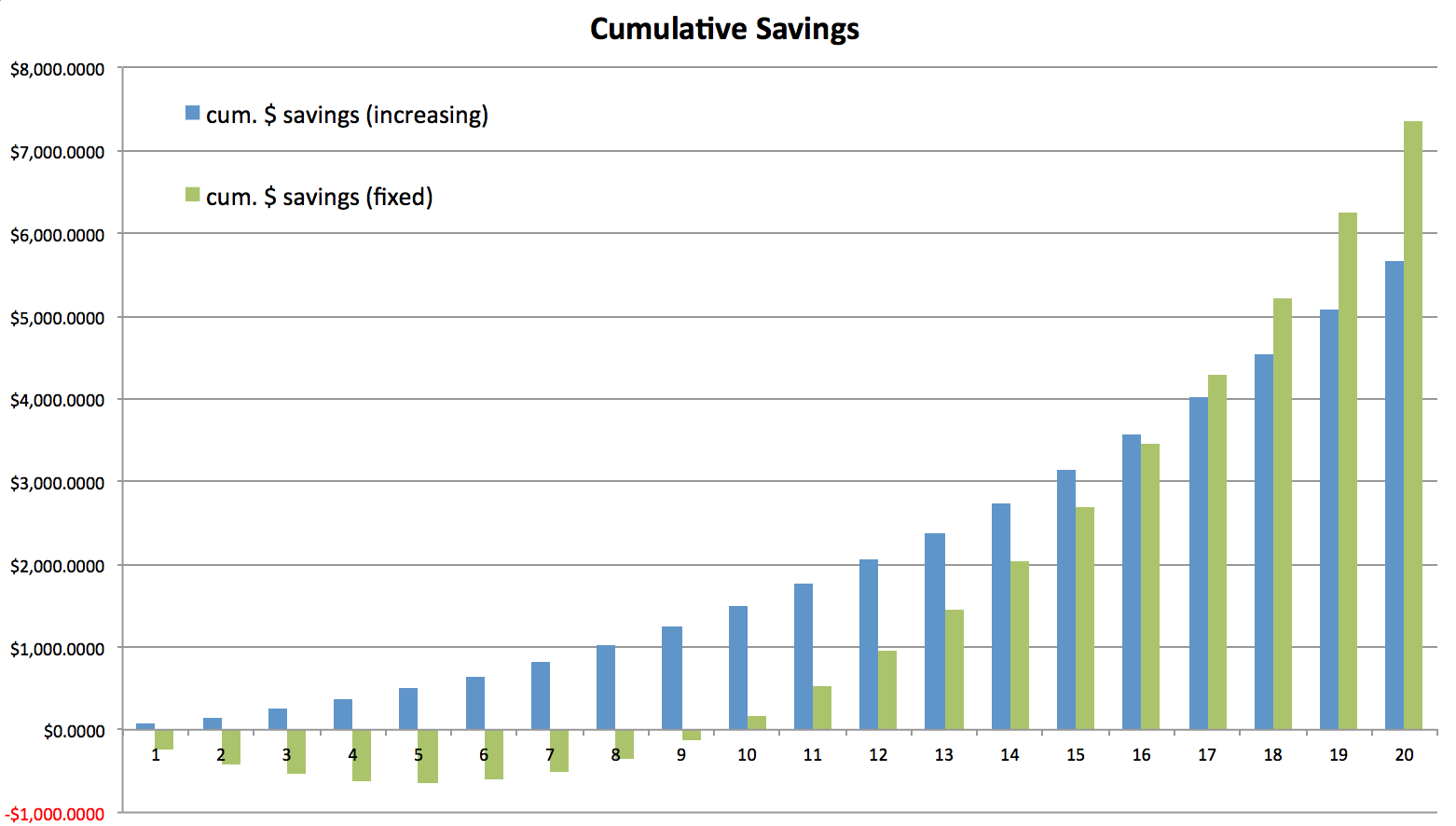Three Reasons We Went Solar (and You Should Too!)
Last June, I called my buddy Mike and told him I wanted to go solar. We were about to move into our new house and I wanted him to look at the roof on Google Maps to confirm it would be worth installing solar panels. At the time he was a salesman (he's since been promoted) for Solar City Tesla, and I know he'll always be honest with me even when he's trying to sell me something.
Six days ago (in terrible weather for solar energy production) we turned our system on!
Solar energy is really hot right now. Every time I mention our system on Facebook and Twitter I get more people asking me for details about what we paid, how much we're saving, and so on. Everybody wants in. And the good news is it's unbelievably easy, and the savings are real.
Here's our electric consumption compared with our solar production for yesterday. And remember, it's almost winter here in the northern hemisphere, so we're almost opposite of ideal conditions. This is only going to get better during the summer!

Here, then, are the very first three reasons that come to mind when asked why I wanted to go solar, and you should too:
1: It's good for the planet!
The sun is a renewable energy source that will be around billions of years after the last humans die (if we stay on our current trajectory, at least), and it's free. Just look up. Feel that warmth on your face? Free energy.
Not dumping tons of carbon and other gross polution into the atmosphere is another added bonus.
Really, do I have to sell the whole "it's good for the environment" thing that hard? I think pretty much everyone agrees that solar energy is much better than fossil fuels and easier to harness than wind or water.
2: Elon Musk, evil genius
Of course, Solar City Tesla makes some money from the contract they sign with you. How else would they pay for sales staff, installers, and so forth?
The federal government provides a nice Alternative Energy Credit to the owner of the solar system. Since we lease our system from Solar City Tesla, they own it, and they get to pocket that AEC. Then there's the profit from selling any over-produced energy back into the grid. I'll cover some of the details from that in a later section, but for now just know: They make a profit and Elon Musk turns around and reinvests that money in making the world a better place. (That's my educated guess based on his current interests: Solar City Tesla Solar, Tesla Automotive, SpaceX, etc)
I love supporting a business that's out to make the world better, not just to make the shareholders rich.
3: We save money & it costs us nothing*
I know you're cringing at that asterisk. Give me a chance to explain!
No matter what, there are no up-front costs. We've paid nothing so far, and that has covered a site inspector, the installation crew and the solar panels themselves, and a few inspections after installation. All for $0.
We signed a 20 year, fixed-rate contract at a per-kWh rate that is currently higher than what PECO charges. We're paying 15.67 cents per kWh that our solar panels produce, while PECO is only charging 13.9 per kWh that we consume from the grid. The electric utility industry, on average nationally, increases rates by 5% per year, so by year 6 we'll be saving money compared to PECO, according to those projections.
Our contract is the green bars, and the PECO projection is the red bars.

But what are those blue bars? That's where the asterisk comes in.
We chose a contract that has a higher initial per-kWh rate initially, but is fixed for 20 years. We're going to lose a little bit of money every year until that fixed rate is lower than the PECO rate. But...
For people that want to start saving money immediately, Solar City Tesla offers a similarly-increasing rate plan, but the amount it will increase is fixed at 2.9% and will not change for the life of your contract; and they start you out lower than PECO rates, so you start saving immediately. As you can see, the blue bar starts below the red bar and never goes above it.
How much more are we going to save over the life of the contract by signing up for the fixed rate (green bar) plan?

At the end of your 20 year contract, you've saved a bunch of money... And contributed to saving the planet in a meaningful way! But what's the real dollar difference between the two plans? In order to calculate this we need a rough estimate of the number of kWh used per year, which for my family is currently about 9,200 kWh/y.
On the increasing rate plan (blue bar), we would save about $66 in the first year, and by the end of year 20 we would have saved a combined total of $5,658 and change (about $282/year). On the fixed rate plan (green bar) we're going to lose money for the first few years, and then once our rate is better than PECO's it's going to take a few more years worth of savings to recoup those first years losses; but then the savings take off. We'll lose $229 in our first year, and in year 5 our total combined loss will be up to $637 and change (about $127/year). But by year 20, including those losses up front, we will have saved $7,367 and change compared to the PECO projection (about $368/year).
Because we're willing to take a little bit of a loss for the first few years, we'll save roughly an extra $1,700 over the 20 years of the contract.
This is probably a good time to mention that your rates will vary. These numbers are all based on what my electric utility is charging me, and the rates that
Solar CityTesla offered me. Unless you live near me, your starting rates will probably differ, and the rates thatSolar CityTesla offers you will probably differ. But the intent will be the same.
How can they afford to do this?
I don't have special access or Nate-Silver-like abilities to divine truth from seemingly unrelated numbers, but there are a few things that we know for sure.
Solar CityTesla charges you nothing for your panels and other expenses (installation, etc), and recovers those costs through income streams; making it really easy for anyone with appropriate roof space to get involved. For the average consumer, the cost of the panels alone would be prohibitive to going solar independently.- The federal government (and perhaps some states?) incentivize alternative energy with Alternative Engergy Credits, which is basically a rebate they pay you for using clean energy like solar power. That goes to the owner of the solar system, which is
Solar CityTesla, not you. - Your electric utility will pay
Solar CityTesla for any energy your system pushes back into the grid (after net metering)
What's net metering?
When you use electricity from the grid, your power meter spins in one direction. If you produce more energy than you consume, it will be pushed back into the grid and your meter will spin backwards.
Now imagine someone reading your meter on the 1st of the month, and it's at 5,000. When she comes back to read it on the 1st of the following month, it's at 5,300, and you're charged for 300 kWh of usage. But what the meter doesn't show is that during the beginning of the month the weather was outstanding and your meter spun backwards to 4,800; before the sky turned black and you had to start drawing energy from the grid again.
All that matters is that your net usage from the grid was 300 kWh. That's net-metering.
If the reading on the 1st day of the second month was 4,500, that would represent 500 kWh pushed back into the grid, and they would pay you rather than the other way around.
Sounds great, where do I sign up?!
If you're in a state where they operate, get in touch with them! Or, if you'd rather start talking directly with a person (and I know you), get in touch with me and I'll put you in contact with my salesman Mike.
Referral Disclosure
I wrote this post because I couldn't keep up with people asking me for details on my solar setup. I believe in the company (I signed a 20 year contract with them!) and I believe they will do right by you, too. I wouldn't share this information if that weren't true. But, in the interest of disclosure, I do stand to make a little bit of money if you sign up.
If you use my referral link to initiate contact with Solar City Tesla and you ultimately do get a solar system installed, you and I both get $250.
I hope you do, for our planet's sake.